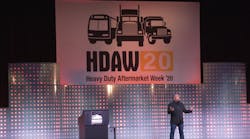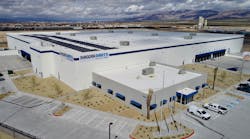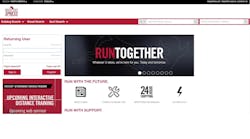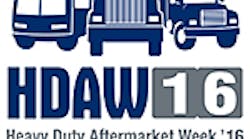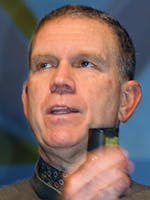IF you aren’t fully leveraging technology, you’re losing the race. Sure, you might not be losing money, but you’re falling behind your competitors.
“More and more, technology is moving from being a utility to a competitive weapon in the market,” said Scott Klososky, founding partner of consulting firm Future Point of View LLC. “If you go back 20 or 30 years ago, technology was thought of as utility. It did the accounting, did a lot of back-office things. It still does: warehouse management, distribution systems. But more and more, it’s moving to systems of engagement: websites, mobile applications.
In his presentation, “Technology Trends: How to Compete in Current and Future Conditions,” Klososky said we’re living right in the middle of the digital transformation, so we’ve lost sight of how historical it is.
“I’m 53,” he said. “I didn’t grow up with PCs—didn’t have them until I was 18 or 19 years old. They didn’t even exist. Today, we can get any piece of information instantly.
“When we were young, we would all go to a library. We would actually have to read the book. Now, when you move into the business world, we don’t have to talk to human beings to get information on your products. They can go online and do a search and within seconds can find anyone in the world that distributes what you distribute.
“Everything has become connected. People are connected. Devices are becoming more and more connected, information streams are becoming connected. It will feel like devices come alive. As they become connected, they start to know us. The vehicle will know when you are headed home. It will alert your home. The house will change. There are things it will do, knowing I’m on the way home. It will seem very normal to us and we will become upset if the house doesn’t know we’re coming home.”
He said that as processes become automated, that changes the job structure in the world. A lot of people ask, “If computers start doing everything, what will humans do?” Klososky believes there will always be a world for humans, but there will be a dramatic shift over the next couple of decades in terms of what human beings do—what our value is versus what technology can do.
“Mobile phones are now our outboard brain, psychologists say,” he said, “because they store memory, so we don’t have to store as many small bits—telephone numbers, birthdays, addresses. A high percentage of the time, people go to this device to solve the problem. They have access to huge amounts of information. We used to have it in our brain and now it’s in the phone.
“If you are a manufacturer or distributor and have put out catalogs for years and years, understand that as this becomes the outboard brain, this is what people want to go to for information. So if you’re one of the ones in your industry without a mobile app, that’s an issue.
“If you don’t move quickly enough to put your content into a mobile format, you will flat lose market share. It might be just younger people, but as they get older, they are more of your market.”
He said that how we find customers and nurture relationships is dramatically changing, and it’s increasingly important to find the “humalogical balance”—the integration of humans and technology to get things done.
“There is a humalogical balance to almost every process today,” he said. “If you have to do an installation on a vehicle, it is part technology and part human. If you’re selling something and delivering through FedEx, that’s part human and part technology. The scale starts off with a zero, which is a 50-50 human and technology concept. Today, driving a car is pretty much a zero. The car doesn’t get anywhere without a human, the human doesn’t get anywhere without the car.
“Amazon is trying to be as far over the ‘T’ end of the scale as possible. Amazon is the #1 trusted brand on the Internet and this is a brand that has almost no human contact with anybody. The whole sales model of (founder) Jeff Bezos is all electronic. More than that, robots are moving brown boxes in his warehouse and he wants to have drones deliver his packages. Jeff Bezos wants himself, five assistants, and an army of robots. His business model is to be way over on ‘T’ side.”
He said businesses have to ask, “Where is our business on the scale, and are we in the right place?”
“If you get too far to one side or the other, you hurt yourself from a profitability or productivity standpoint,” he said. “This is modern leaders, 2.0 leaders.”
Low-beam leaders can’t think past 12 months, “or this quarter, if you’re publically traded,” he said.
“Sometimes we’ll call that ‘management,’ so it’s not necessarily bad, because you’re forced to just execute,” he said. “But a lot of you in the room today are high-beam leaders. You’re in a leadership position where we’re depending on you to have a vision that is accurate about where things are going to go. There’s no place more than technology where you need to get this right. You’d better not watch technology happen and think that you don’t need to move quickly and you can just copy your competition.
“High-beam leaders have a 5- to 10-year view, high VQ—vision intelligence—do trend analysis, are willing to experiment, and do predictive analysis.
“One of the big advantages of distribution is you can hold inventory and have it close to the source, but how much will 3D printing change that? Half of your distribution business will be having 3D printers in the room and just printing the products you distribute. You have to understand this is what high beam is like and how things like this might change your market. Then you have to decide, how fast do you have to move?
“There’s an old saying, ‘Slow and steady wins the race.’ But now we’re in a world where that’s not true. It’s as simple as when there is a tool available, there is a speed at which you will adopt it. The problem with slow adoption is it creates a risk gap, because if other people are adopting faster than you are, they are grabbing market share from you. The latest saying is, ‘Fast and furious wins the race.’ ”
Klososky believes a business has to consciously pick where it wants to be on the innovation curve. On one end is the bleeding edge (which gives you a four-year lead on your competitors), and on the other is the laggards (which puts you two years behind). The leading edge gives you a two-year advantage and the middle of the pack is the general market.
“You want to be coming out with new technology uses or devices a little bit ahead of others in the market,” he said. “Then you have a technology halo. In your industry, customers know who uses technology better. Starbucks is always a year or two in front of its competitors.”
On the digital innovation continuum:
• Web 1.0 is connected organizations (websites, ecommerce).
• Web 2.0 is connected people (social, mobile, cloud). “That allowed anyone in the world to talk to anyone instantly, or anyone to talk to a group instantly, or any company to talk to millions of people with the press of a button for almost nothing.”
• Web 3.0 is connected devices (Internet sharing data). “Devices talking to each other and devices that know us.”
• Web 4.0 is connected information (platforms, ambient intelligence).
He said that companies that want to make money need to pay attention to Web 3.0 and Web 4.0.
“We have one foot in 3.0 and the seeds of 4.0 are already planted,” he said. “I already see that when I look at what GM is doing with OnStar and how they are gathering data on vehicles. I look at the amount of data and what they are starting to do with it in building relationships, and it’s an interesting thing.”
How might truck equipment distributors and trailer dealers put the coming technology to work in managing inventories, evaluating sales and shop performance, and other common functions? ♦

